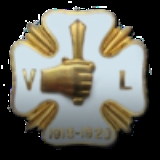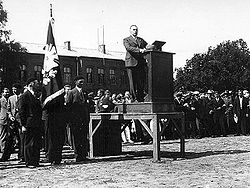
League of Liberators
Encyclopedia
Vaps Movement, the Union of Participants in the Estonian War of Independence was originally an Estonia
n association of veterans of the Estonian War of Independence (1918–1920), later also non-veterans were accepted as its members. The organisation was founded in 1929, emerged as a mass anti-socialist and anti-parliamentary movement. It allegedly tried twice to overthrow the government of Konstantin Päts
, once in 1934 and a second time in December 1935. The leaders of this association were Andres Larka
(formal figurehead and presidency candidate) and Artur Sirk
.
and openly criticized the Nazi persecution of Jews
, it also lacked the willingness to use violence
, or the goal of territorial expansion. They were known for wearing a black beret
as their uniform headgear. Moderate members of the movement (such as Johan Pitka
) gradually left the organization and new members were allowed to join, who were not veterans. The organization issued its own newspaper, Võitlus.
 In an October 1933 referendum
In an October 1933 referendum
on constitutional reform, what was unsuccessfully attempted since 1926, was approved by 72.7 percent of the voters. The organization was banned by Jaan Tõnisson
's (who opposed the constitutional reform) government under state of emergency before the referendum, but after this event organization was re-established and became even more radical. The league spearheaded replacement of the parliamentary system
with a presidential form of government
and laid the groundwork for an April 1934 presidential election, which it expected to win. After the League won absolute majorities in local elections in the three largest cities at the beginning of 1934, but not in the most rural self-governments nor small towns and boroughs, the recently elected constitutional president Konstantin Päts
declared a state of emergency in the whole country (in certain parts, this was already in effect since 1918) on March 12, 1934, disbanding the Vaps movement and arresting its leading figures. Konstantin Päts established a moderate regime that the historian Georg von Rauch has called Authoritarian Democracy. In 1935, a National Association was formed to replace political parties and series of state corporate institutions were introduced.
The league was officially banned and finally disbanded in December 1935. On May 6, 1936, 150 members of the league went on trial; 143 of them were convicted and sentenced to lengthy terms of imprisonment. They were granted an amnesty and freed in 1938, by which time the league had lost most of its popular support. By 1 January 1938, a new constitution took effect and new parliament was elected in February 1938. The new constitution reduced the powers of the presidency.
and wore black berets as their symbols.
's nationalist movements such as Lapua Movement
, Patriotic People's Movement (Finland)
and Academic Karelia Society
.
Estonia
Estonia , officially the Republic of Estonia , is a state in the Baltic region of Northern Europe. It is bordered to the north by the Gulf of Finland, to the west by the Baltic Sea, to the south by Latvia , and to the east by Lake Peipsi and the Russian Federation . Across the Baltic Sea lies...
n association of veterans of the Estonian War of Independence (1918–1920), later also non-veterans were accepted as its members. The organisation was founded in 1929, emerged as a mass anti-socialist and anti-parliamentary movement. It allegedly tried twice to overthrow the government of Konstantin Päts
Konstantin Päts
Konstantin Päts VR I/1 and III/1 was the most influential politician of interwar Estonia. He was one of the first Estonians to become active in politics and started an almost 40-year political rivalry with Jaan Tõnisson, first through journalism with his newspaper Teataja, later through politics...
, once in 1934 and a second time in December 1935. The leaders of this association were Andres Larka
Andres Larka
Andres Larka VR I/1 was an Estonian military commander during the Estonian War of Independence and a politician....
(formal figurehead and presidency candidate) and Artur Sirk
Artur Sirk
Artur Sirk was an Estonian political and military figure. A veteran of the country's struggle for independence Sirk later became a leading figure within the right-wing Vaps Movement and an outspoken opponent of the government-Early years:A native of rural Järvamaa, Sirk came from a humble...
.
Ideology
The Vaps Movement was a paramilitary organisation with most of its base being the lower middle class. They had no elaborate ideology or any connection with foreign fascist movements, their goal was simply a more authoritarian and nationalist government in Estonia. The league rejected racial ideologyNazi eugenics
Nazi eugenics were Nazi Germany's racially-based social policies that placed the improvement of the Aryan race through eugenics at the center of their concerns...
and openly criticized the Nazi persecution of Jews
Persecution of Jews
Persecution of Jews has occurred on numerous occasions and at widely different geographical locations. As well as being a major component in Jewish history, it has significantly affected the general history and social development of the countries and societies in which the persecuted Jews...
, it also lacked the willingness to use violence
Violence
Violence is the use of physical force to apply a state to others contrary to their wishes. violence, while often a stand-alone issue, is often the culmination of other kinds of conflict, e.g...
, or the goal of territorial expansion. They were known for wearing a black beret
Beret
A beret is a soft, round, flat-crowned hat, designated a "cap", usually of woven, hand-knitted wool, crocheted cotton, or wool felt, or acrylic fiber....
as their uniform headgear. Moderate members of the movement (such as Johan Pitka
Johan Pitka
Johan Pitka, VR I/1, KCMG was a famous Estonian military commander from the Estonian War of Independence until World War II.-Early life:...
) gradually left the organization and new members were allowed to join, who were not veterans. The organization issued its own newspaper, Võitlus.
Constitutional reform

Referendum
A referendum is a direct vote in which an entire electorate is asked to either accept or reject a particular proposal. This may result in the adoption of a new constitution, a constitutional amendment, a law, the recall of an elected official or simply a specific government policy. It is a form of...
on constitutional reform, what was unsuccessfully attempted since 1926, was approved by 72.7 percent of the voters. The organization was banned by Jaan Tõnisson
Jaan Tõnisson
Jaan Tõnisson VR I/3, II/3 and III/1 was an Estonian statesman, serving as the Prime Minister of Estonia twice during 1919 to 1920 and as the Foreign Minister of Estonia from 1931 to 1932.-Early life:...
's (who opposed the constitutional reform) government under state of emergency before the referendum, but after this event organization was re-established and became even more radical. The league spearheaded replacement of the parliamentary system
Parliamentary system
A parliamentary system is a system of government in which the ministers of the executive branch get their democratic legitimacy from the legislature and are accountable to that body, such that the executive and legislative branches are intertwined....
with a presidential form of government
Presidential system
A presidential system is a system of government where an executive branch exists and presides separately from the legislature, to which it is not responsible and which cannot, in normal circumstances, dismiss it....
and laid the groundwork for an April 1934 presidential election, which it expected to win. After the League won absolute majorities in local elections in the three largest cities at the beginning of 1934, but not in the most rural self-governments nor small towns and boroughs, the recently elected constitutional president Konstantin Päts
Konstantin Päts
Konstantin Päts VR I/1 and III/1 was the most influential politician of interwar Estonia. He was one of the first Estonians to become active in politics and started an almost 40-year political rivalry with Jaan Tõnisson, first through journalism with his newspaper Teataja, later through politics...
declared a state of emergency in the whole country (in certain parts, this was already in effect since 1918) on March 12, 1934, disbanding the Vaps movement and arresting its leading figures. Konstantin Päts established a moderate regime that the historian Georg von Rauch has called Authoritarian Democracy. In 1935, a National Association was formed to replace political parties and series of state corporate institutions were introduced.
The league was officially banned and finally disbanded in December 1935. On May 6, 1936, 150 members of the league went on trial; 143 of them were convicted and sentenced to lengthy terms of imprisonment. They were granted an amnesty and freed in 1938, by which time the league had lost most of its popular support. By 1 January 1938, a new constitution took effect and new parliament was elected in February 1938. The new constitution reduced the powers of the presidency.
Symbols
They used Roman saluteRoman salute
The Roman salute is a gesture in which the arm is held out forward straight, with palm down, and fingers touching. In some versions, the arm is raised upward at an angle; in others, it is held out parallel to the ground. The former is a well known symbol of fascism that is commonly perceived to be...
and wore black berets as their symbols.
Foreign Relations
They have had a good relationship with the FinlandFinland
Finland , officially the Republic of Finland, is a Nordic country situated in the Fennoscandian region of Northern Europe. It is bordered by Sweden in the west, Norway in the north and Russia in the east, while Estonia lies to its south across the Gulf of Finland.Around 5.4 million people reside...
's nationalist movements such as Lapua Movement
Lapua Movement
The Lapua Movement , was a Finnish radical nationalist and anti-communist political movement founded in and named after the town of Lapua. After radicalisation it turned towards far-right politics and was banned after a failed coup-d'état in 1932...
, Patriotic People's Movement (Finland)
Patriotic People's Movement (Finland)
Patriotic People's Movement, abbreviated to IKL), was a Finnish nationalist and anti-communist political party. IKL was the successor of the previously banned Lapuan liike...
and Academic Karelia Society
Academic Karelia Society
The Academic Karelia Society was a Finnish elitist nationalist and Finno-Ugric activist organization aiming at the growth and improvement of newly independent Finland, founded by academics and students of the University of Finland in 1922...
.
In recent times
- Jüri Liim claims to be restoring the original Vaps Movement. But he didn't get an registration and his organization is illegal.

